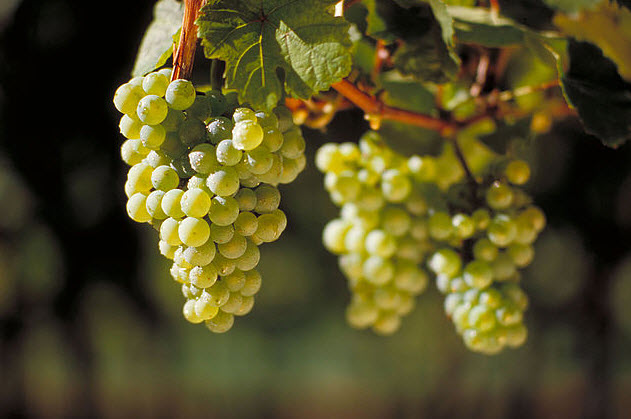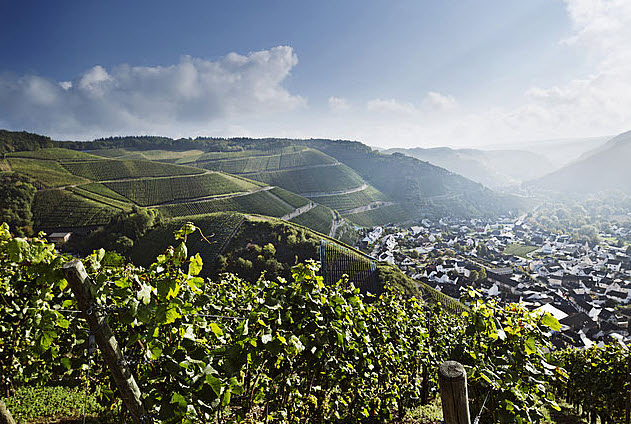Someone has a big birthday on March 13th. Here to tell us more about that is Natalie MacLean who offers North America’s most popular online wine classes.
Welcome Natalie.
So who’s celebrating a birthday this Sunday?
Although it’s actually a grape, it’s so personable that you’re right to call it someone, Bob ;) The iconic German white wine grape turns 588 this Monday; it was first written about in 1435. Yet it’s irrepressibly young and vibrant, looking not a day older than 585.

What makes German Riesling so special?
Riesling is a tough-skinned little berry that loves the cool climate and soils of Germany. That’s why it’s planted on almost one quarter of all vineyards in the country and is considered the benchmark style for the grape around the world.
Dr. L Riesling
Mosel, Germany
One of the most iconic winemakers is Dr. Ernie Loosen, and I have his Dr. L Riesling here. It’s bursting with aromas of lime, lemon zest and sunshine. Like many other wineries he makes a range of wines, starting with this entry level wine at only $ and progressing to ultra premium styles at hundreds of dollars per bottle.
Wow that’s quite a range. What else would surprise us about German Riesling?
It’s made in a variety of styles from bone dry to sweet.
Deinhard Dry Riesling
Rheinhessen, Germany
For example I have two wines from Deinhard here, one dry and the other off dry, or just a touch of natural sweetness as there’s no sugar added.
Deinhard Winery Green Label Riesling
Mosel, Koblenz, Germany
These wines will pair beautifully with spicy dishes and curry that’ll defeat other wines.
You mentioned German soils. How do they affect the wines?
An ancient river carved out the gorgeous Mosel Valley over millions of years, depositing minerals and slate, a rock that fractures easily so water runs down to the river. Without much water, the vines are challenged to survive and their roots have to dig down through the rock to find sustenance. Riesling thrives on suffering. I like that in a plant and in a person. What doesn’t kill you makes you stronger.

I have with me Clean Slate from the Mosel and you can see the fissured rock on the label. The vineyards are so steep in this valley, they have to strap the grape pickers into harnesses so they don’t roll all the way to the bottom.
Clean Slate Riesling Mosel
Mosel, Germany
You also referenced the cool climate. How does that shape the wine?
Riesling vines can withstand winter freezes as low as -20oC, cold enough to kill less hardy plants between growing seasons. In fruit as in people, complexity is built under difficulty. The Mosel is on the same 50th parallel as Krakow, Winnipeg and Mongolia.

Winemakers plant the vines angled to soak up warmth from the light reflected from the various waterways.
The Bend In The River Riesling
Pfalz, Germany
I have another Riesling here aptly called Bend in the River. It’s zesty and mouth-watering, perfect for the spring dishes and patio sipping we’ll be enjoying soon.
You’ve mentioned the Mosel. How many regions in Germany plant Riesling?
There are 13 regions growing this grape, with 23,800 hectares, producing more than 50% of the world’s Riesling. The Mosel and Rheingau regions have the longest tradition for producing this wine.
Moselland Bernkasteler Kurfurstlay Riesling
Mosel, Germany
I have two more wines I’d like to share with you: Moselland and Relax. They both have this nervy, racy acidity that makes your mouth water with prickling excitement.
Relax Riesling
Mosel, Germany
Acidity is also what makes wine food-friendly. It is to wine what salt is to food, bringing forward flavour.
How can we learn more about German Riesling?
There’s lots of buzz on social media right now if you search on the hashtag #rieslingbirthday

Thank you Natalie! You’ve posted all of these wines on your website at www.nataliemaclean.com.
Images courtesy of Wines of Germany. Posted with permission from CHCH.















